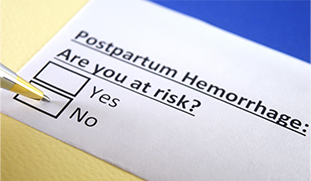Postpartum Hemorrhage: Prevention and Treatment
Six days after giving birth, Ayesha Ahmed nearly died from postpartum hemorrhage (PPH) – excessive bleeding that can occur within 24 hours to 12 weeks after delivery. Here’s her story:
After giving birth to her son, Parvez, Ayesha experienced excessive bleeding and a loss of appetite. Her doctor declared that she was bleeding normally as any new mother does after giving birth and dismissed her anxiety. Her mother-in-law later found her passed out in front of the bathroom. She was rushed to the hospital and had lost a lot of blood and was diagnosed with a hemorrhage.
The blood loss had damaged her kidney and heart! A hysterectomy, surgical operation to remove all or part of the uterus, was necessary to save her life. On being asked, she blames the lack of education around topics that are related to women for her loss. Even though she will no longer be able to carry another child, she is grateful for her son, Parvez.
According to a report published in BJOG: An International Journal of Obstetrics and Gynecology, postpartum hemorrhage (PPH) is the No. 1 cause of maternal death in India, and worldwide.
The approximate amount of blood loss after vaginal delivery is 500 ml, and for cesarean birth it is 1000 ml. With PPH, you can lose a dangerous amount of blood which can cause a severe drop in blood pressure. Without immediate treatment, it can also lead to shock and death.
PPH is something every mother should be aware of. In this blog, we’ve compiled everything you need to know about PPH in one place.
What are the causes of postpartum hemorrhage?
Once the baby is delivered, the uterus contracts and pushes the placenta out. Once the placenta is delivered, the uterine muscles contract even further and clamp the placental blood vessels shut. But if the uterus is too soft or weak and does not contract strongly enough, these blood vessels bleed freely. This is called uterine atony – the most common cause of postpartum hemorrhage.
Sometimes, the entire placenta doesn’t separate itself from the uterine wall which can also cause increased bleeding.
Damage to your vagina, cervix, uterus, perineum, or other pelvic muscles can also cause hemorrhage. In rare cases, blood clotting disorders can interfere with your body’s clotting ability and cause you to bleed uncontrollably.
Who is at risk for postpartum hemorrhage?
Some risk factors can include:
• Previous history of PPH.
• Multiple pregnancy (e.g., twins or triplets).
• Prolonged labor or rapid labor.
• Uterine atony, or the inability of the uterus to contract properly after delivery.
• Medical conditions, such as preeclampsia, clotting disorders or anemia.
• Maternal age over 35 years old.
• Obesity.
• Cesarean delivery.
What are the signs and symptoms of postpartum hemorrhage?
You may have PPH if you notice any of the following symptoms of PPH:
• Uncontrolled bleeding
• Drop in blood pressure and signs of shock, like increased heart rate, blurry vision, fatigue, dizziness, having chills, or feeling faint
• Nausea
• Pale skin
• Abdominal or pelvic pain
• Pain around the vagina or perineum – the area between the genital and rectum
Contact your doctor immediately if you feel any of the symptoms above in the days or weeks after delivery.
How is postpartum hemorrhage diagnosed?
Your doctor will diagnose PPH by reviewing your health history and through visual and physical examinations, and lab tests. These tests include measuring your:
• Blood loss
• Heart rate and blood pressure
• Red blood count and other clotting factors
How is postpartum hemorrhage treated?
The main aim of postpartum hemorrhage treatment is to find and stop the cause of the bleeding as soon as possible and restore the lost blood volume.
Treatments can include:
• Uterine massage or medications to help the uterine muscles to contract.
• Removing any remaining placental tissues.
• Repairing the vaginal, cervical, and uterine tears.
• Bakri balloon or a Foley catheter to put pressure on the uterine walls and seal off blood vessels.
• Blood transfusion.
In rare cases when other treatments fail, your doctor may perform hysterectomy – a surgical removal of the uterus.
Postpartum hemorrhage is a very serious condition. However, quick detection and treatment can often lead to a full recovery. Recovery will be different for everyone based on the amount of blood lost and how their doctor treated it; but eat healthily, drink lots of water, and rest as much as possible.


FAQ's
Certain risk factors put you at greater risk for postpartum hemorrhage than others and knowing them can help you and your doctor prepare accordingly. Most cases of postpartum hemorrhage occur at the time of delivery or soon after. Early care can reduce the amount blood loss and prevent postpartum hemorrhage.
The treatment for postpartum hemorrhage will depend on the cause of the bleeding. If you are planning to have a child or are going to give birth soon, you can discuss everything about postpartum hemorrhage and its risk factors and treatment with your doctor.


